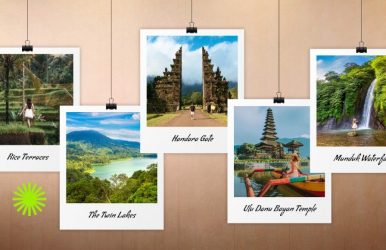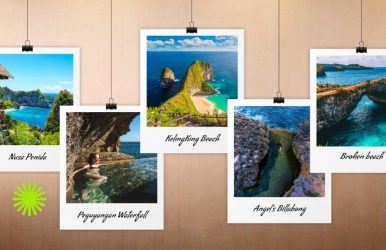Uluwatu Beach: The Prettiest Beach In Bali (A Hidden Gem With Stunning Sunsets, Surfing And Serenity)
BY Sibashree Aug 27, 2025
The recent demolition of over 40 business settlements at Bingin Beach of the Uluwatu region may apparently seem a disturbance for a region that caters to global tourists. However, the demolition has happened for a greater good, as it will eventually protect this important coastal region. In other words, the declaration of demolition by the House of Representatives will help Bingin Beach and the Uluwatu region to protect them from the perils of overtourism and overdevelopment. If you see the larger picture, it is only a boon for the surfing heritage of Bali. Along with the Uluwatu Beach, Uluwatu is home to many other beautiful beaches. The stunning cliffs, awe-inspiring sunsets, and world-class surf breaks here make it a safe haven for travelers who seek the perfect fusion of tranquility and adventure. On the other hand, the Uluwatu Temple, with its unique architecture and spiritual ambiance, is a place for introspection. Overall, Uluwatu is a place where nature, spirituality, adventure, and wildlife co-exist to ensure a wholesome experience for every traveler. What’s more? Let’s have a close encounter with the Uluwatu Beach in this Tour and Travel Blog. In this blog, I will cover the following key topics. Table of contentsWhy Is Uluwatu Beach The Prettiest Beach In Bali?Why Is The Uluwatu Beach So Famous?1. A World-Class Surfing Destination2. Uluwatu Temple3. A Hub Of Serenity4. Unbeatable Sunset ViewsHow To Reach Uluwatu Beach?What Are The Things To Do At Uluwatu Beach?1. Surfing And Swimming2. Visiting The Uluwatu Temple3. Have Good Food And Enjoy A Great Time At The Beach Clubs4. Explore The Secret Beaches Of UluwatuWhat Are The Best Beaches In Uluwatu?Where To Stay In Uluwatu Beach?Itinerary For Uluwatu Beach: Make The Most Of Your Time At Uluwatu Beach Why Is Uluwatu Beach The Prettiest Beach In Bali? Uluwatu, a part of the Bukit Peninsula in Southern Bali, is the prettiest with its stunning cliffs, coastlines, and crystal-clear waters. In the truest sense, you can call Uluwatu a hidden gem, as you can only access it through a steep set of stairs. These stairs descend the grand limestone cliffs. As you climb down the stairs, you will see the most amazing views of the ocean and the coastline. Moreover, as you reach the beach, the soft golden sands will kiss your feet, and the stretches of turquoise water before your eyes will almost feel transcendental. Amidst this natural beauty and a true juxtaposition of cliffs and the sea, Uluwatu also promises a luxurious experience, as the cliffs surrounding the beaches have luxurious resorts and beach clubs. Moreover, the Uluwatu Temple is the crown jewel of this dreamy destination. It is the spiritual hub of this beach paradise, and from here, you will get a panoramic view of the ocean and the surroundings. Why Is The Uluwatu Beach So Famous? From being a bustling surfing hub to being a space for finding tranquility amidst the chaos of Bali, Uluwatu remains one of the most sought-after beach destinations in the country. Furthermore, the Uluwatu Temple and amazing sunset views offer you more reasons to visit Uluwatu. 1. A World-Class Surfing Destination With powerful and consistent waves and reef breaks, Uluwatu is an iconic surf spot. The left-hand reef breaks are especially ideal for beginners and experienced surfers. 2. Uluwatu Temple Pura Luhur Uluwatu, or Uluwatu Temple, is a powerful spiritual center of Uluwatu, and it is even one of the most prominent temples of Bali, protecting the island from evil spirits. The temple has also emerged as an important cultural destination, with Kecak Fire Dance being performed here at sunset every day. The dance performance highlights the story of the Ramayana in which Lord Rama kills Ravana and announces the triumph of good over evil. Brahma, Vishnu, and Lord Shiva, the holy trinity of Hinduism, are the presiding deities of the temple. Moreover, you will be able to spot long-tailed macaque monkeys here. 3. A Hub Of Serenity Uluwatu continues to maintain its serene charm when other parts of Bali, such as Seminyak and Kuta, struggle with the perils of overcrowding and overtourism. The place is less commercialized, and thanks to the decision of the House of Representatives to demolish illegal constructions here, the beach will continue to maintain its pristine charm. 4. Unbeatable Sunset Views Uluwatu is also one of the most photogenic and Instagrammable places in Bali. It has the most beautiful sunset, with the Sun dipping below the horizon and spreading the most vibrant colors over the cliffs and the ocean water. How To Reach Uluwatu Beach? You can take a rental car or scooter to reach Uluwatu from the Denpasar airport or various other parts of Bali, such as Seminyak, Canggu, and Kuta. From the airport, it is a one-hour ride to Uluwatu Beach, and from the other three places, the journey will take around 45-60 minutes. What Are The Things To Do At Uluwatu Beach? Uluwatu promises the most unique experience with water activities, temple visits and the most vibrant nightclub experience. 1. Surfing And Swimming Uluwatu beach is ideal for surfers of all expertise levels. It has many surf schools that guide the beginners. Furthermore, if you are an experienced surfer, you can visit the reef breaks to see the power of the waves. 2. Visiting The Uluwatu Temple As I mentioned, for an amazing spiritual and cultural experience, you can visit the Uluwatu Temple. You will love the fire dance and the unique architecture of the place. Furthermore, it is located on top of a cliff. So, you will enjoy the most amazing views of the surroundings. 3. Have Good Food And Enjoy A Great Time At The Beach Clubs Uluwatu is the place to find the most stylish beach clubs in Bali. You will find comfortable daybeds here. Also, you can enjoy some amazing cocktails and local cuisine while soaking in the ocean vibe. El Kabron and Single Fin are some noted beach clubs here. 4. Explore The Secret Beaches Of Uluwatu Are you ready to explore beyond the main Uluwatu beach? You will love exploring the following secret beaches. Padang Padang Beach Pantai Bingin Dreamland Beach Enjoy the beauty of crystal clear waters, soft sun, and beautiful coastal views. What Are The Best Beaches In Uluwatu? Padang Padang, Bingin, and Suluban are my favorite beaches in Uluwatu. Further, among these three, my silent favorite is Suluban. It is a rocky beach, and with the waves consistently hitting a height of 4-5 meters, it is a surfer's paradise. Also, swimming here feels like swimming in a big cavern. Moreover, it is the Suluban beach, which is alternatively called the Uluwatu Beach. What Is The Best Time To Visit Uluwatu Beach? The dry season of Balu, from April to October, is the best time to visit Uluwatu. The warm and sunny weather in these months makes the situation ideal for surfing and other beach activities. November to March is also a decent time to visit the Uluwatu Beach. Despite the rain, these months remain suitable for surfing and swimming. However, July to August is the peak tourist season in Uluwatu. Early mornings and late afternoons are the ideal times of the day to explore the Uluwatu Beach. Where To Stay In Uluwatu Beach? View this post on Instagram A post shared by Anantara Uluwatu Bali Resort (@anantarauluwatu) You will get budget, mid-budget, and luxury accommodations in Uluwatu Beach. The most luxurious accommodations here are Anantara Uluwatu Bali Resort and Banyan Tree Ungasan. From Infinity pools to private villas, these luxurious accommodations offer the best hospitality. Courtyard by Marriott Nusa Dua is a popular mid-budget accommodation in Uluwatu. Moreover, you can choose budget-friendly options such as Padang Padang Breeze. Itinerary For Uluwatu Beach: Make The Most Of Your Time At Uluwatu Beach Let’s have a look at this 2-day itinerary at the Uluwatu Beach. Days at the Uluwatu BeachThings to DoDay 1 • Morning: Arrive in Uluwatu and take in the beach views. Start your day with a refreshing swim in the turquoise waters or sign up for a surf lesson if you’re keen to try your hand at surfing.• Afternoon: After lunch at a nearby café, head to the Uluwatu Temple to enjoy the stunning views and explore the temple grounds.• Evening: End your day by watching the Kecak Fire Dance performance at the temple. Afterward, enjoy dinner at one of the nearby beach clubs, like Single Fin, where you can catch the sunset while enjoying delicious food and drinks.Day 2• Morning: Head to Bingin Beach or Padang Padang Beach for a quieter, more secluded beach experience. Spend your morning lounging on the sand or swimming in the clear waters.• Afternoon: Take a leisurely lunch at one of the seaside cafés. Spend the afternoon enjoying the serenity or take part in a yoga session at one of the nearby resorts.• Evening: For your final evening, visit one of Uluwatu’s upscale cliffside restaurants for an unforgettable dinner with panoramic views of the ocean. Uluwatu Beach: Frequently Asked Questions (FAQs) Here are some frequently asked questions and answers about Uluwatu Beach. 1. Is Uluwatu Beach Safe For Swimming? Uluwatu Beach has strong waves and currents. So, it is more suitable for surfers than traditional swimmers. Furthermore, you must only stick to the designated surfing zones and follow the instructions of the guides for a safe surfing experience. 2. What Should I Wear To Uluwatu? Beachwear is ideal for Uluwatu. However, you have to dress modestly when visiting the Uluwatu Temple. Your knees and shoulders need to be covered. You will even get a sarong at the temple entrance. 3. Does Uluwatu Have A Great Nightlife? Yes, Uluwatu offers you an amazing nightlife. You will find many sophisticated cliffside bars and beach clubs. Also, there are many live music and dance venues in Uluwatu. El Kabron, Single Fin, Ulu Cliffhouse, and Savaya Bali are some popular destinations to enjoy the vibrant nightlife of Uluwatu. Read Also: Where Is Nusa Penida Island? (With Location, Direction, Why Is Nusa Penida Famous, And What’s Going On) Bali Beyond The Beaches: Exploring The Hidden Gems Of The Island Planning a Vacation to Bali? Read This Blog!























